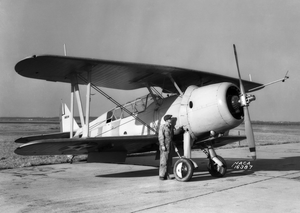Vought XSB3U
| XSB3U-1 | |
|---|---|
 |
|
| Role | Scout bomber |
| Manufacturer | Vought-Sikorsky |
| First flight | 1936 |
| Status | cancelled |
| Primary user | United States Navy |
| Number built | 1 |
| Developed from | SBU Corsair |
| Type | Prototype |
| Serial | 9834 |
The Vought XSB3U was an American biplane scout bomber developed by Vought-Sikorsky for the United States Navy during the 1930s. Developed as an alternative to the SB2U Vindicator monoplane, the aircraft proved unsatisfactory to the Navy in comparison, and development was not pursued.
In late 1934, the U.S. Navy's Bureau of Aeronautics (BuAer) issued a specification for new scout bomber and torpedo bomber designs. Eight companies submitted ten designs in response, evenly split between monoplanes and biplanes.
Exemplifying the Bureau of Aeronautics' reluctance to fully embrace the monoplane configuration for carrier-based aircraft, the XSB3U-1 was proposed as a more conventional alternative to Vought's XSB2U-1, which was designed as a modern monoplane. The XSB3U was modified from the last production SBU Corsair, using essentially the same airframe, including a fully enclosed cockpit, and Pratt & Whitney R-1535 radial engine, but with a more streamlined surface and cowling. In addition, the XSB3U had fully retractable landing gear.
The XSB3U-1 was delivered to Naval Air Station Anacostia for evaluation by the U.S. Navy in April 1936;, at the same time as its primary competition, the XSB2U-1. Comparative testing of the two aircraft during 1936 proved the complete superiority of the monoplane configuration; on the same power, the SB2U-1 was 15 miles per hour (24 km/h) faster despite being larger and heavier than the biplane. However, the Navy was impressed by the XSB3U's method of landing gear retraction, which provided a more streamlined surface after retraction than most other methods used at the time.
...
Wikipedia
